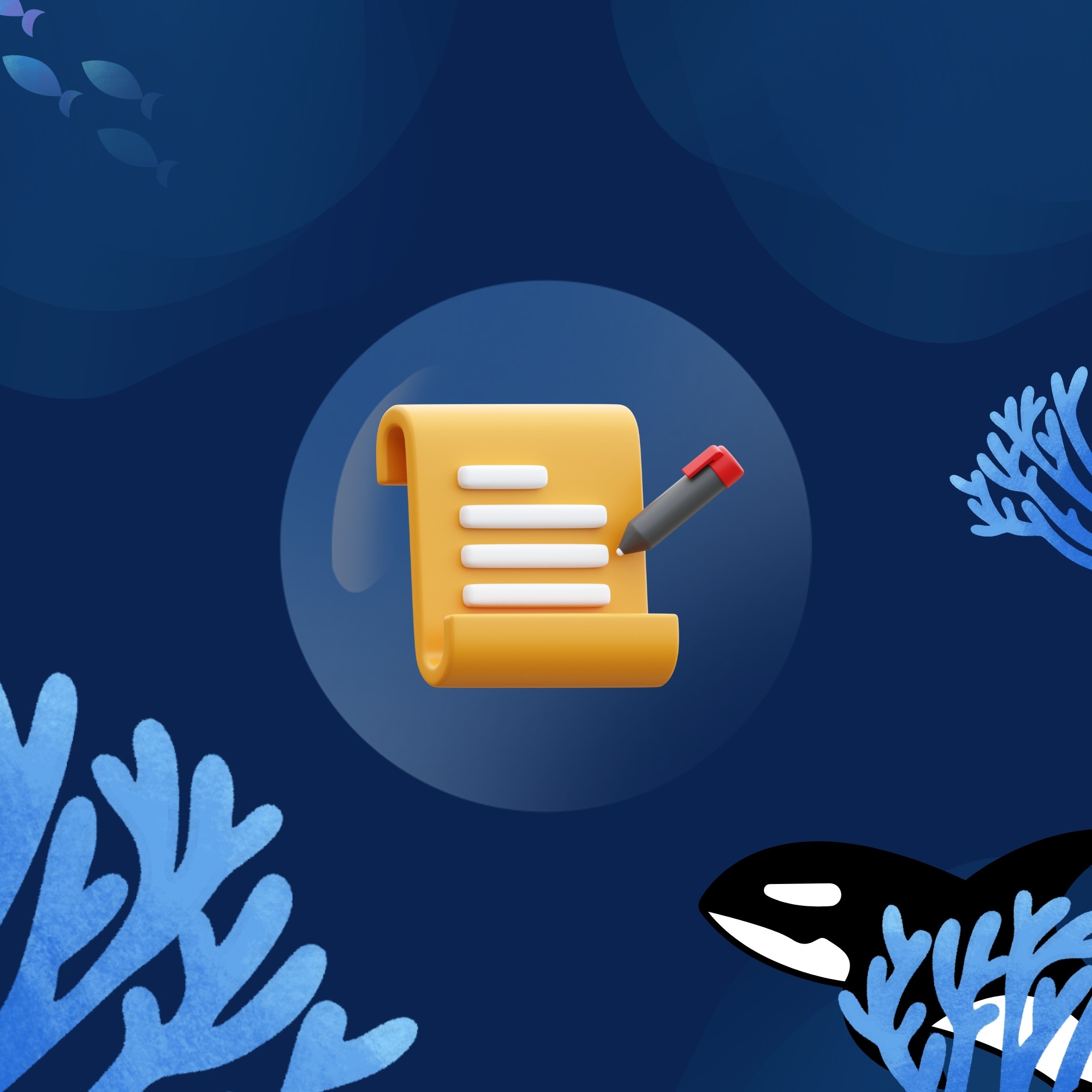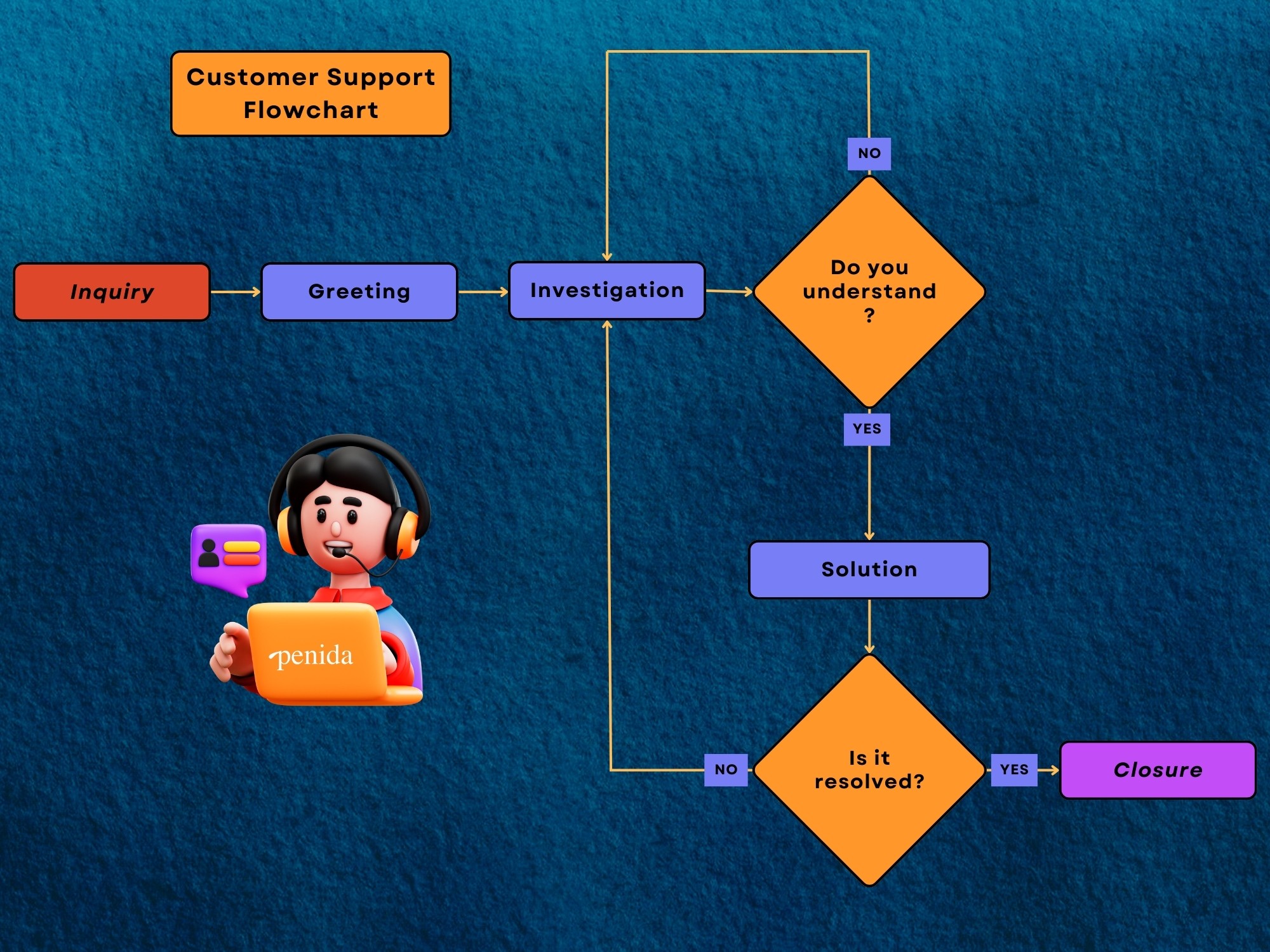Maximize Call Center Success with Scripts!
Learn key script strategies for call center and chat success to enhance CX.

Charles Password
May 7, 2024
Sticking to a script isn't just okay… it's a smart approach!
By identifying effective greetings, questions, and closures, and consistently using them, you ensure reliable and high-quality customer support at any scale.
Here's an easy to follow guide on creating an an effective support script:
Importance of Scripts in Customer Support
Benefits of scripts
Crafting the Perfect Chat Support Script
Key components on a customer support script
Customer Support FlowChart
Breakdown of Customer Support Scripts
Greeting Breakdown
How a great greeting can make a customer love you
Examples of great greetings
How a bad greeting can make customer dread talking to you
Examples of bad greetings
Personalization Breakdown
How great personalization can make you more interesting
Examples of great personalization
How bad personalization can make you a weirdo
Examples of bad personalization
Investigation Breakdown
What are clarifying questions?
Asking clarifying questions serves multiple purposes
How sucking at asking questions wastes valuable time
Examples of bad questions
How asking great questions saves valuable time
Examples of great clarifying questions
Solution Breakdown
How a great solution can prevent a customer from coming back
Examples of great solutions
How a bad solution can double your support workload
Examples of bad solutions
Closure Breakdown
How a great closure can make a customer remember you forever
Example of a great closure
Example of a bad closure
Final Thoughts
Remember the following points
Importance of Scripts in Customer Support
I like to think of customer support scripts like roadmaps for your support team. They provide direction and structure to conversations and a well designed script can significantly enhance the customer experience, offering quick and accurate responses.
Benefits of scripts:
Provides direction and structure to conversations
Reduces need to think of greetings, questions and closure
Decreases response time resulting in an increase in customer satisfaction
71% of customers state that valuing their time is the most important thing a company can do to provide them with good service. Scripts enable representatives to address issues promptly, which ultimately decreases response time and thereby increases customer satisfaction.
Crafting the Perfect Chat Support Script
Just as the anatomy of the human body is essential to its functionality, the structure of a support script is crucial for its effectiveness. By following a well-organized format, I ensure consistently high-quality and efficient support in all my conversations.
Key components on a customer support script:
Greeting: A friendly and inviting opening that sets a positive tone such as
Investigation: Ask at least 3 clarifying questions to understand the customers' issue thoroughly.
Personalization: This is very dynamic and the key is to connect with the customer.
Solution: Provide clear and concise information or steps to resolve the customer's concern.
Closure: A warm and polite sign off that leaves the door open for further assistance.
Customer Support FlowChart

Breakdown of Customer Support Scripts
Here we will breakdown the four components of our Customer Support FlowChart. This includes the Greeting, Personalization, Investigation, Solution, and Closure.
Greeting Breakdown
How a great greeting can make a customer love you
It's unrealistic to be at your 100% all the time, but sticking to a well crafted script can help maintain a positive tone regardless of your mood. By following a structured flowchart and adhering to my script, i was able to make sure that my greetings remained consistent, friendly and most important welcoming! Customers loved to come into chat knowing the can expect an enthusiastic response. One of the most significant positive impacts I saw when building my customer support dream team was increased customer satisfaction during periods when I was not feeling it.
Examples of great greetings:
Warm and Friendly
"Hey there! Hope you are doing well today. How can I assist you?"
"Hello! This is [Agent Name]. How can I help you today?"
Personalized and Engaging
"Hi [Customer's Name]! It's great to see you. How can I help you today?"
"Good [morning/afternoon/evening], [Customer's Name]! How can I assist you today?"
How a bad greeting can make customer dread talking to you
Coming off as uninterested and bored is a terrible idea when initializing a conversation with anyone. It makes it seem as if you have no interest in talking to the customer. Which is why for me the hardest part about customer support has been staying consistent with my tone especially when "burnout" kicks in.
Examples of bad greetings:
"Hey there."
"Yea, I am here, how can i help you?"
These greetings are impersonal and show a lack of interest, which can immediately bring down the customer and set a negative tone for the rest of the conversation.
Personalization Breakdown
How great personalization can make you more interesting
My favorite way of personalizing a chat is referring to the customers country and attempting to learn more about them. If you are able to get this data from your preferred CRM, it can be used to connect with your customer without being to weird. I applied this from my "How to win friends and influence people" reading by Dale Carne, where he states, "To be interesting, be interested.". Show people you are interested in learning about them, and to them you automatically become the most interesting person in that moment.
Examples of great personalization
"Very cool! I noticed the store is based out of [Customer Country] and i have been interested in visiting! Do you have any food spot recommendations as im a big foodie hehe"
"That's interesting! I noticed you are based out of [Customer Country] and i've heard wonderful things of that area. How’s the weather there today?"
"Wow, I see you're using our application for [Specific Purpose]. How’s that been working out for you?"
These examples show how the lite use of customer data can be a great entry for personalizing support.
How bad personalization can make you a weirdo
Getting to personal to the point where it almost seems like you are a weirdo is a terrible idea. You want to avoid using any data you might have that may be to personal such as names(if they never gave it to you), specific city/town they are in, or anything that makes you look like a stalker..
Examples of bad personalization
"Hey there [Customers Name], how are you doing today?"
"Hey there [Customers Name, I see you are from [Customer Specific Location]! That is very cool :) "
These examples can feel intrusive and may make customers uncomfortable, especially if the information used was not shared by them during the interaction. The key is to avoid acting like Joe from the netflix series "You".

Investigation Breakdown
What are clarifying questions?
Clarifying questions are an essential component of an effective customer support script. The thing is that when it comes to creating these question you will have to adjust it dependent on the type of inquiry the customer comes with. The important thing is to realize that these questions will drastically increase your customer support efficiency due to the overall reduction in miscommunication.
Asking clarifying questions serves multiple purposes:
Improves Problem Solving Efficiency
Reduces Risk of Miscommunication
Enhances Customer Satisfaction
How sucking at asking questions wastes valuable time
Asking irrelevant questions or assuming you automatically know what the issue is based off the first message from the customer is a big no no. You are more likely to misunderstand the question if you base your hypothesis on the first statement the customer makes. What i tell my team is that we should act as if we are "Doctors" and ask as many relevant questions as needed to understand the root of the issue. A Doctor will always ask questions relevant to the situation and not things that end up making the situation even more confusing.
Examples of bad questions
"AHHH i completely understand what you mean! This is how i would solve it…"
"Can you explain that more please?"
The first example is what i would completely avoid until i have asked at least 3 clarifying questions. While the second example is not being clear of what needs to be explained.
How asking great questions saves valuable time
When i receive a customer inquiry the first thing i do is attempt to breakdown the question into smaller digestible parts. This helps me be able to understand the customers issue in an organized manner and ask questions that end up helping me resolve the issue. I noticed that whenever i asked higher quality questions i received high quality answers that made solving the issue much easier. This is why i started following my rules of asking at least 3 clarifying questions before giving a solution
Examples of great clarifying questions
"Can you tell me more about [Specific part of the issue] you're facing? For instance, when did it start happening, and what specific actions lead to the problem?"
Just to confirm, am i understanding this correctly? [Rephrase customer's question or statement]"
"Could you please provide more details about [Specific part of the issue]? Are there any error messages or specific details you've noticed?"
Solution Breakdown
How a great solution can prevent a customer from coming back
"Give a man a fish, and you feed him for a day; teach a man to fish and you feed him for a lifetime". This Chinese proverb can be applied to many aspects of our lives but in my case i applied it to resolving customer support inquiries. Instead of just telling a customer how to do something in as little detail as possible, i did the opposite. I would instead take extra time to offer clear easy to understand solutions and include additional information and screenshots wherever possible. By doing so customers not only had their issue resolved but also obtained deeper knowledge which can help prevent future issues.
Examples of great solutions
"Got it! Here’s what we can do to fix this:
Step one: [Instructions + Screenshot].
Step two: [Instructions + Screenshot].
Step three: [Instructions + Screenshot]."
"Thank you for the information. Here’s what we can try:
Step one: [Instructions + Screenshot].
Step two: [Instructions + Screenshot].
Step three: [Instructions + Screenshot]."
Notice how in both variations we list out the steps in an organized manner and provider instructions and screenshots of the solution.
How a bad solution can double your support workload
There was nothing worse than spending hours with a customer only to realize the solution i gave them lack depth and they still had more questions the next day. Clear and detailed solutions helps avoid there is less chance of missing details that could help the customer better understand the solution.
Examples of bad solutions
"Got it! Here's what we can do to fix this: [Step 1, 2, 3 instructions unorganized with no screenshots]
"Thank you for the information. Here's what we can try: [Step 1, 2, 3 instructions unorganized with no screenshots]
The difference is in how we organize the steps and provide additional information that could be helpful long term.
Closure Breakdown
How a great closure can make a customer remember you forever
For me it is really important for a customer to know that i truly enjoyed talking to them. When writing my closing statement i aim for a positive and welcoming exit so that they know i appreciated my time with them and that they can always count on me to be there.
Example of a great closure
"Thank you so much for your patience and kindness with me today! If you have any more questions, you can count on us to be here for you always!"
That is my simple and tested example i personally always use (or some variation of it)
Example of a bad closure
"Bye for now"
If someone responded like this to me in chat support i would not even respond to that. So best avoid closures like this if you are trying to maintain high customer satisfaction
Final Thoughts
Structuring your live chat script in a similar way can help you create a framework for consistent, high quality interactions that leave customers feeling heard and helped.
Remember the following points:
Follow the Customer Support FlowChart
Inquiry -> Greeting -> Personalization -> Investigation -> Solution -> Closure is dependent on the type of Inquiry.
Try to stick to Personalization to connect with the customer.
Make sure to understand the inquiry before entirely suggesting solutions.
Provide easy to understand solutions.
Keep the Greeting and Closure warm and friendly.
A well written script can be the difference between dealing with a 30-minute conversation and just a quick/efficient 10-minute conversation.
Stay cool and collected my people and i will see you in our next article! Bye for now ;)
Charles Password
Penida CEO
Solopreneur co-founded a top Shopify apps studio with over 42k users—An innovator with a knack for engaging e-commerce solutions.
